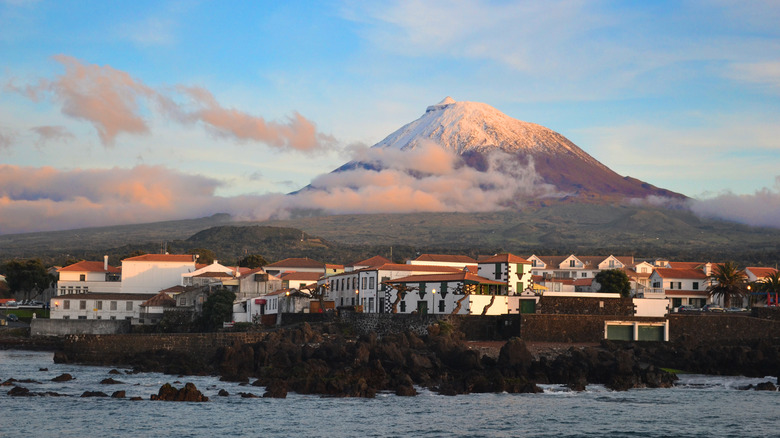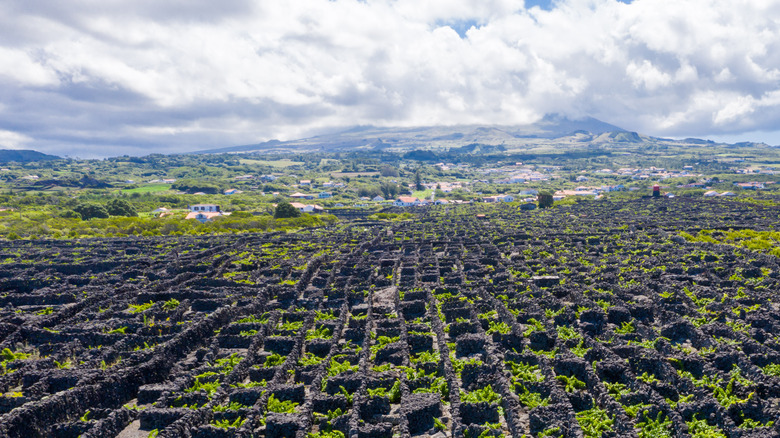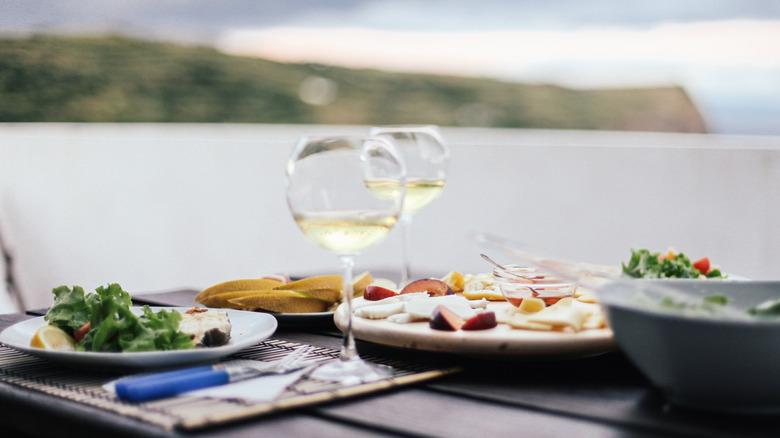Visit This Remote Portuguese Island To Sample One-Of-A-Kind Volcanic Wine
Pico, one of the middle islands in the Portuguese archipelago of the Azores, is a land of contrasts and surprises. The locals call it "the black island" for its preponderance of black rock, which contrasts sharply with the villages' bright white buildings, orange tile roofs, and vermilion gates and doors. Pico Mountain — Portugal's tallest mountain at 7,713 feet — just out of the island's center, draped in deep green forests and watching over the towns like a proud mãe, or Portuguese mother. However, Pico Mountain — besides being tall — is not your average high hill. That's because it's actually a quiescent volcano, one of many in the Azores islands.
The volcanic origins of the Azores islands, including Pico, are responsible for their dramatic geology and rich soil. Early Azorean settlers exploited the fertility of the land and the temperate climate to create a thriving agricultural industry that for centuries has produced cereals, tropical fruits, tea, and volcanic wine. Volcanic wine thankfully does not explode on the table — its cultivation techniques, mineral, and salty undertones are what make it unique across the world. Volcanic wine is produced throughout the islands, but Pico is currently its epicenter.
Pico's volcanic vineyards
Wine growing on Pico dates back to the 15th century, enabled by "the Pico miracle that transformed vast extensions of rock into fertile fields of vineyard," as described by the Bullar brothers in 1839. This is how the "miracle" works — volcanic rock walls are constructed in a criss-cross pattern to form small vineyard plots that protect vines from the salty wind blowing in from the ocean. The dark rocks in the walls and additional rocks inside the plots also absorb sunlight during the day and emit this energy as heat overnight. This creates a stable microclimate that supports grape ripening.
The resulting vineyards have an otherworldly appearance, like black honeycombs stretching across the landscape between the massive Pico Mountain and the ocean. These vineyards have changed little over the centuries, a testament to early settlers' ingenuity and diligence. Pico's vineyards were declared a UNESCO World Heritage site in 2004 in light of their immense cultural value. Visit wine museums such as the Museo do Vinho or the Centro de Interpretação da Paisagem da Cultura da Vinha da Ilha do Pico to learn more about Pico's wine heritage.
Wine experiences on Pico
To fully comprehend Pico's volcanic wine, you need to see the vineyards for yourself. The best way to do that is to drive or walk south along the coast from Madalena, the island's main town. After a few miles, you'll arrive at the Paisagem da Vinha de Criação Velha, where you can take it all in. Another area with well-preserved vineyards is northeast of Madalena near the Paisagem da Cultura da Vinha da Ilha do Pico.
After seeing how Pico's volcanic wine is grown, the next step is to taste it! The island produces many different volcanic wines: whites, reds, roses, and others. One highly regarded white is Frei Gigante, named after the Franciscan friar who introduced wine to Pico in 1450. This is a delicate, fragrant white that pairs perfectly with grilled fish and tart Azorean cheeses. You can sample Pico wines at any of the island's bars or restaurants, some of which have wine flights with prime examples from each category. In addition to having wine flights, the Cella Bar has a stunning terrace overlooking the ocean on which to sip them — an added bonus. If you prefer to have a local to guide you during your aqueous exploration, wine tours are also available on Pico.


